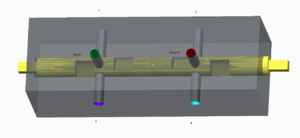Open Source Solenoid Valve
Electrical controlled valves are necessary in order to remote-control machines from the GVCS. However, the solenoid valves for the power level of interest cost about $200 per double-acting channel - see CEB Press v16.09. There is thus a strong case for open source solenoid valves, which we could produce for probably 1/5 of that cost.
Development Strategy
Based on the success with the double clamp design of clamp blocks in the 3D Printer Design Evolution - and specifically 3D_Printer_Log#Wed_Aug_17.2C_2016 - we can add metal plates to the flat faces of 3D prints. Further, we can print thermoplastic elastomer planar or o-ring seals. ABS is 6000 PSI strong. Combined with 50 ksi metal plates, we should be able to achieve open source 3D printed solenoid valves for hydraulic applications at 2000 PSI. If not, then the least would be lower pressure applications. For the higher pressure applications, it may be necessary to do metal casting, such as lost PLA casting.
Requirements
30 gallon per min (~115 l/min) hydraulic flow at 3000 psi (~200 bar) pressure.
How does it usually work
All solenoid valves I saw till now work similar.
http://img.youtube.com/vi/5jspoB6_YuI/default.jpg http://img.youtube.com/vi/eKqfP2F_Pl0/default.jpg
I spool is centered inside of the body with springs. On both sides of the body are electromagnets that can push a shaft that presses the spool towards the other side. Therefore you can realize three different states of operation.
Ideas for simplification
As I see it the most difficult part to produce is the body as there are very complex geometries inside that can only be formed by casting or 3D-printing. For that reason I concentrated on simplifying the geometry of the body.
Possible solutions
The body is a simple metal block with only ordinary drill-holes and threads, easy and cheap to manufacture. The outputs 1 and 2, and 3 and 4 have to be connected width hoses to allow double-acting. Connecting them outside of the block with possibly quite cheap hoses might make the whole thing cheaper than produce the complex forms necessary to work otherwise.
Possible issues
- The form of spool shown above will most probably form turbulences that might be a problem.
- All surfaces have to be very accurately to enable leak tightness.
Industry Standards
- Air - 150 psi - [1]
SMEs
- From Mathias Heingartner - Rudolf Scheidl: rudolf.scheidl@jku.at. This is the homepage of his department: http://www.jku.at/imh/content - I sent him an email and told him vaguely about OSE, I thought it best that you talk to him yourself, so I said that you would be in touch. You should also check out this: http://www.lcm.at/en/portfolio/digitale-ventile-fsvi/ The LCM is a techfirm tightly connected to my university.
